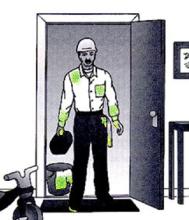Lead-Safe Wisconsin: Protecting Employees from Lead Exposure
Your employees are your company’s most valuable asset, but they can be affected by lead exposure in the workplace.
We want to help you keep your employees and their families safe by taking steps to protect them from lead exposure.
Images from the National Institute for Occupational Safety and Health
- View a list of ways to keep your employees safe from lead, which includes:
- Replacing products that contain lead with products that don’t contain lead, or contain a lower amount of lead, when possible. When replacement isn’t possible, train workers on lead hazards and safe work practices.
- Providing employees with effective lead removal products.
- Providing employees with adequate personal protective equipment (PPE)
- Conducting routine blood lead level (BLL) testing for those who may be exposed.
- Use occupational health consultation services to evaluate and improve your hazard control measures. The Wisconsin State Laboratory of Hygiene’s WisCon program offers free on-site consultation services, including:
- Hazard assessment.
- Help with OSHA (Occupational Safety and Health Administration) compliance.
- Help developing controls.
Services are provided by professionals like:
- Engineers
- Industrial hygienists
- Nurses
Use these messaging points when talking to your employees about the dangers of lead exposure:
- No amount of lead is safe, even for adults.
- Lead accumulates over time in the bones and other parts of the body, but that over-time amount of lead does not show up in blood lead levels.
- You can carry lead home with you from work, and it can be especially harmful to children and pregnant women.
- If you work around lead, regular BLL tests are important to know your current level of exposure.
Talking to pregnant or breastfeeding employees, or employees planning to have a child, about lead
Tell your employees who are pregnant or breastfeeding—or employees planning to have a child—about the OSHA lead standard, which states, “the physician may recommend special protective measures or medical removal for an employee who is pregnant or who is planning to conceive a child when, in the physician’s judgment, continued exposure to lead at the current job would pose a significant risk.”
Use these messaging points in the conversation:
- It’s especially important when you’re pregnant or breastfeeding, or planning to have a child, that you know how to protect yourself when working directly with or near lead.
- If you’re pregnant or planning to become pregnant, talk with your doctor about lead exposure in the workplace.
- If you’re breastfeeding and exposed to lead while breastfeeding, talk to your baby’s pediatrician to see if you should have their BLL tested.
- The results of all residents’ BLL tests must be reported to the Wisconsin Department of Health Services (DHS).
- DHS follows up on adults who have a high BLL result. Many of these adults were exposed to lead in the workplace.
- DHS reports employee BLL results to their employer and requests more information from the employer if the results show significantly elevated lead levels, measuring 40 µg/dL or higher.
Use this OSHA lead standard summary table (PDF) for a snapshot of general guidelines related to:
- Air monitoring
- Compliance methods
- Employee notification of test results
- Employee training
- Medical removal
- Medical surveillance
Here is the complete OSHA lead standard for both construction and general industry:
- Keep Your Family Safe: Don’t Bring Lead Home from Your Job, P-01737
- Lead and Your Health, P-01738
- New Jersey Department of Health’s fact sheet: Right to Know: Hazardous Substance Fact Sheet (PDF) (Spanish version)
- Protecting Shipworkers from Lead, P-01625 (PDF)
The CDC’s (Centers for Disease Control and Prevention) National Institute for Occupational Safety and Health offers resources on workplace safety and health:
Adult Lead Program
Wisconsin’s Adult Lead Program is part of its Occupational Health and Safety Surveillance Program.
dhsocchealth@dhs.wisconsin.gov
608-266-1120
Employers, employees, and union officials can request a free health hazard evaluation of their workplace. They can also contact the CDC with questions about lead in the workplace. The phone number to call is 800-CDC-INFO (800-232-4636).


